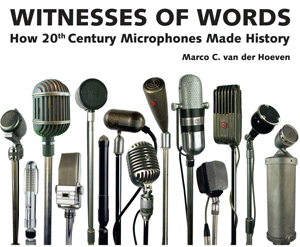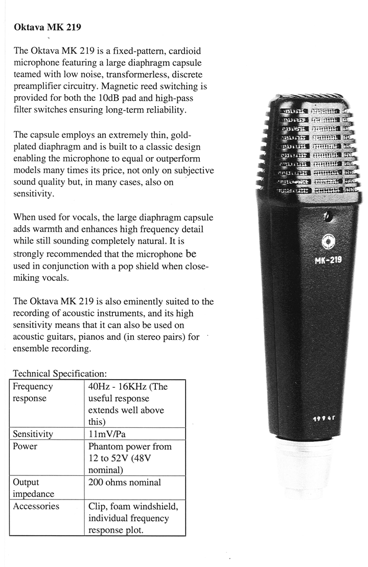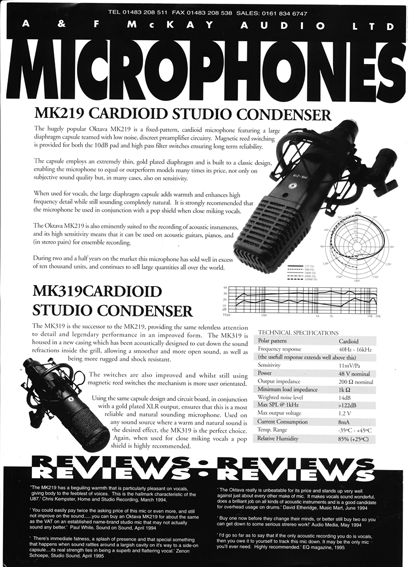|
When it was introduced in the West in 1994, the Oktava MK 219 was the first affordable large-diaphragm studio condenser microphone. It cost approximately €350, less than a quarter of the price of a studio microphone at the time. In 1994, there were no Chinese condenser microphones for sale, nor had the budget-friendly Röde NT1 and NT2 arrived on the market.
Although the MK 219 is probably in the top three of ugliest microphones ever built, it quickly became popular with budget studios and home recording enthusiasts who couldn't afford the expensive Neumann or AKG large-diaphragm microphones. As the price dropped even further, it became the microphone every serious recording enthusiast wanted.
The sound of this ugly Russian proved to be excellent; nice and round, not harsh, and it was even compared to that of the Neumann U47. With the Gefell UM 70, many claimed they couldn't tell them apart in blind tests. That might be a bit of an exaggeration, but for overheads, acoustic guitar, and even vocals, the MK 219 delivered fantastic results.
The microphone had a gold foil membrane, but a capsule made of plastic, instead of brass. The output transformer and reed (magnetic) switches were of excellent quality. The Russian electronics could be improved, as could the housing, which was angular and produced a hollow sound, because of internal reflections of soundwaves.
Several professional microphone experts made modifications that further improved the microphone's quality. These were available as conversion kits or were carried out by the experts themselves. The most important modifications consisted of better capacitors and resistors and a modification of the grille, which reduced sound reflections. In some modifications, the plastic resonators mounted in front of and behind the capsule to amplify high frequencies were removed.
The microphone was released in the Soviet Union in 1986 and was a simplified version of the similar-styled MK 18, from the 1970s, a studio condenser microphone with a dual capsule and three different recording characteristics: Cardioid, omni, and figure eight. The cardioid pattern had a choice between a wide or narrow setting.
The MK 18 had an external 60-volt power supply, although it could also operate on 48-volt phantom power. The MK 219 also had an external 48-volt power supply at the time, which later became redundant, as virtually all professional mixing consoles could supply that voltage.
Andy and Fergus McKay, who studied to become sound engineers in the UK, had encountered an Oktava MK219 in the college studio and asked their father, who worked in Russia, to source some at the Oktava factory. After he returned with more 219s, the brothers were enthusiastic about the microphones and their low price and managed to strike a deal with Oktava to import and sell them exclusively as Oktava Limited (A.S.M.-Andrew S. McKay). The microphones were marked with the letters 'A.S.M.'
Until 2004, A.S.M. was the only company selling Oktava outside Russia, when the contract was terminated following a lawsuit after the McKays had MK012 small-diaphragm Oktavas copied in China.
They claimed that Russian quality control was inadequate, but the Chinese copies were worse.
Around 2000, a new version of the MK 219 was released: the MK 319, with the same capsule and electronics. This model had a rounded housing and a more subtle grille, but even this version proved to profit from improvement and was frequently modified. The MK 319 also sold well due to its good sound and modest price. In 2013 production of the MK 219 ended.
Since the brutal Russian war with Ukraine, Oktavas have practically disappeared from the Western market, just a few models remain available through a direct online sales channel.
Secondhand MK 219s and 319s are still readily available, and they are definitely worth a look; they often cost no more than €100 and, even without modifications, deliver good results without ever sounding harsh, which is unfortunately the tendency of too many modern condenser mics.
These and many more types feature in my book Witnesses of Words. More information about that can be found at www.witnessesofwords.com

|
|
|
|
Above: The MK219, back and MK18 multipattern
Below: Sound of MK 219 and MK 319, MK319 & info |
|
|
|
 |
|
|


 Video's
Video's Contact
Contact








